Ahmad Maalhagh-Fard1 and Steven H Bernier2*
Department of Restorative Dentistry, Mercy School of Dentistry, University of Detroit, Detroit, Michigan, USA
Clinical Associate Professor, Department of Restorative Dentistry, University of Detroit Mercy School of Dentistry, Detroit, Michigan, USA
*Corresponding Author:
Steven H. Bernier, Clinical Associate Professor
Department of Restorative Dentistry
Mercy School of Dentistry
University of Detroit, Detroit
Michigan
USA
Tel: +3134946780
Fax: +3134946781
E-mail: berniesh@udmercy.edu
Received date: January 19, 2016; Accepted date: February 03, 2016; Published date: February 06, 2016
Citation: Maalhagh-Fard A, Bernier SH. Modification of Divergent Abutments to Achieve Optimal Overdenture Retention. Periodon Prosthodon. 2016, 2:1.
Introduction
Patients with atrophic edentulous mandibles have had their dentition restored using support and retention from endosseous implants [1-3]. Several types of abutments are used to retain the overdentures including the LocatorTM Attachments (ZEST Anchors LLC, Escondido, CA) [4-7].
The LocatorTM attachment presents benefits to both patients and clinicians. This attachment may be used with reduced interarch space constraints and provides the advantage of internal guide planes to facilitate precise insertion. The base attachments can be secured in the overdenture using auto polymerizing acrylic resin at chairside or they may be processed by an indirect method. The male attachment inserts are easily placed at delivery and varying amounts of retentive force may be selected depending upon patient requirements. Replacement of the male attachment insert can be carried out as a brief and careful procedure when indicated [8,9].
Clinicians should perform a comprehensive diagnostic examination to determine the amount of available bone and use a surgical guide to place an implant at an appropriate angulation and location. Panoramic radiographs and computerized tomography (CT or cone beam) scans help achieve this goal. In addition, the soft tissue thickness needs to be considered [10].
In this clinical review, after recent delivery of a new mandibular implant-supported overdenture, a ninty year-old completely edentulous woman returned with two widely divergent endosseous implants supporting two LocatorTM abutments (ZEST Anchors LLC, Escondido, CA). Her chief complaint was her mandibular implant-supported overdenture was not retentive. Examination revealed the implants were placed in excessive lateral divergence (Figure 1).
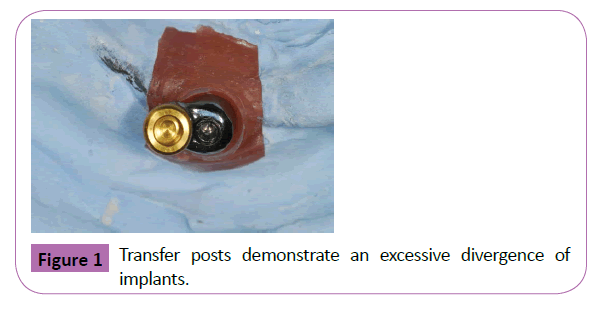
Figure 1: Transfer posts demonstrate an excessive divergence of implants.
The following technique describes a method to provide appropriate overdenture attachment parallelism of divergent implants and afford adequate retention by the fabrication of two mandibular custom LocatorTM abutments to a prescribed angulation and location while providing adequate retention of the mandibular implant-supported overdenture.
Procedure
1. Make an impression of the intaglio surface of the overdenture with polyvinyl siloxane (PVS) putty to the overdenture border after the application of a separating medium. Next, make an impression of oral surfaces of the overdenture with polyvinyl siloxane putty (Figure 2) and duplicate the overdenture in clear autopolymerizing resin (Jet Acrylic, Lang Dental Manufacturing Co. Wheeling, IL).
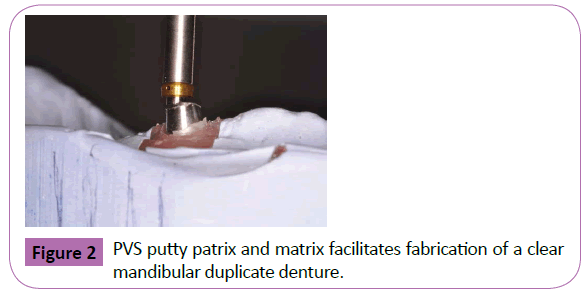
Figure 2: PVS putty patrix and matrix facilitates fabrication of a clear mandibular duplicate denture.
2. Use the overdenture duplicate as a custom tray to make a mandibular impression and to record maxillomandibular relationships (Figure 3).
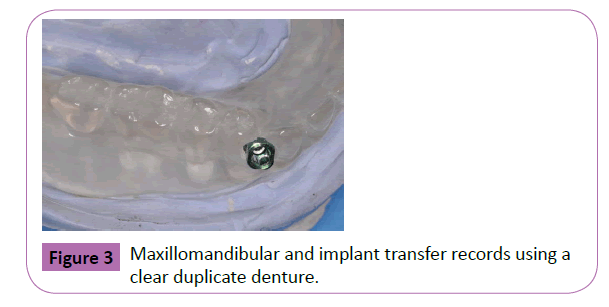
Figure 3: Maxillomandibular and implant transfer records using a clear duplicate denture.
3. Cut through the overdenture duplicate to allow impression coping placements. Make a fixture-level impression using an open-tray technique with the clear overdenture duplicate (Figure 4). Attach an implant analog (ZEST Anchors LLC, Escondido, CA) to the impression coping and fabricate an implant master cast.
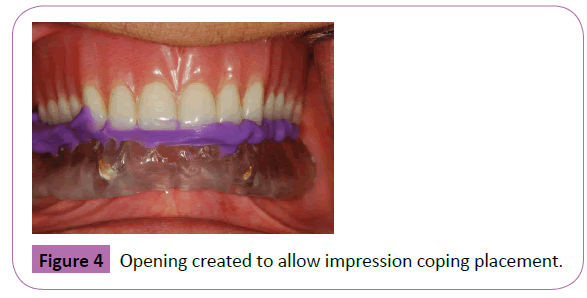
Figure 4: Opening created to allow impression coping placement.
4. Place the cast on a dental surveyor and determine the implant degree of divergence or convergence.
5. Prepare prefabricated titanium abutments to achieve adequate space and proper orientation for the LocatorTM attachments using the duplicate overdenture to confine the attachments within the prescribed location of the prosthetic dental arch.
6. Place the titanium female LocatorTM attachments (ZEST Anchors LLC, Escondido, CA) in a LocatorTM Parallelling Mandrel (ZEST Anchors LLC, Escondido, CA) and secure them to the prepared abutments while aligning them perpendicular to the cast’s occlusal plane. Avoid interference with the abutment screw path of insertion (Figure 5).
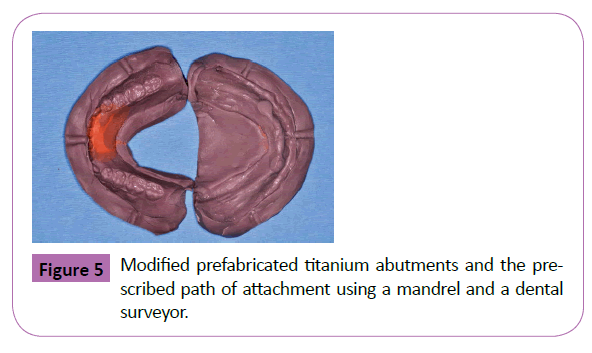
Figure 5: Modified prefabricated titanium abutments and the prescribed path of attachment using a mandrel and a dental surveyor.
7. Laser weld the LocatorTM attachments to the prepared titanium abutments using an Alpha Laser ALP50 Laser Welder (Gramm Technology, Woodbridge, VA) or similar welder.
8. Remove the abutment screws from the abutments and implant analogs.
9. Smooth the abutments with a brown aluminum oxide impregnated silicone polishing point (Brasseler USA, Savannah, GA). Next, polish with Tiger Brilliant Polishing Paste (Dentaurum, Inc. Newtown, PA) and a rag wheel. Secure the abutments to the endosseous implant analogs with new abutment screws (Figure 6).
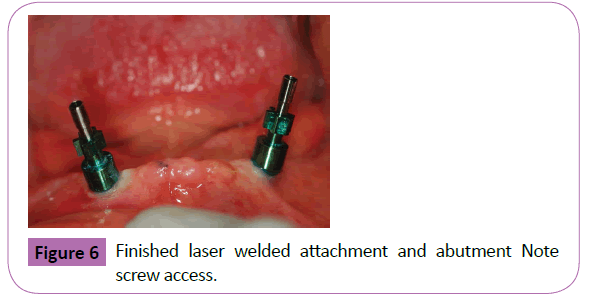
Figure 6: Finished laser welded attachment and abutment Note screw access.
10. Place the abutments and secure the abutment screws to the manufacture’s recommended torque (Figure 7).
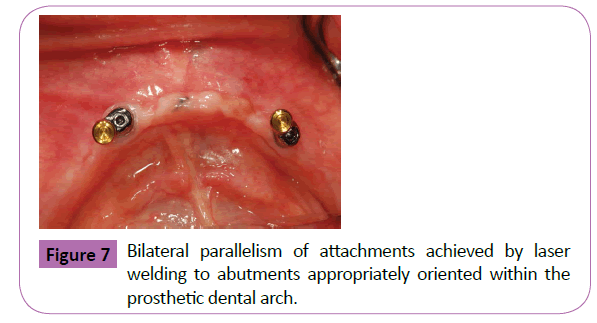
Figure 7: Bilateral parallelism of attachments achieved by laser welding to abutments appropriately oriented within the prosthetic dental arch.
11. Insert the existing, relieved implant-retained overdenture and secure the male attachments with autopolymerizing resin (Quick Up, VOCO America, Inc. Briarcliff Manor, NY, NY) after blocking out any undercuts of the abutments intraorally.
12. Confirm base stability, the engagement of the mandibular implant-supported overdenture to abutments and desired occlusal relationships.
Discussion
Any effective improvement of overdenture base retention should consider expediency, cost, location of attachment within the prescribed prosthetic dental arch and morbidity of treatment in return for satisfactory patient service. Evaluation of an overdenture prosthesis must include an assessment of denture stability and occlusion [11]. An alternative treatment plan may include the fabrication of a cast bar secured by abutment screws with other commercially available base/bar attachment systems or removal and replacement of one implant, if one of the implants is correctly oriented [11]. Resolving the patient’s chief complaint of lack of retention was accomplished in the most economic fashion and without replacement of the prosthesis. Adequate base retention was accomplished by incremental laser welding of attachments to prepared prefabricated titanium abutments with the use of an appropriate mandrel in a dental surveyor.
Summary
A patient presented with divergent mandibular implants. Her chief complaint was lack of retention of her new implant supported overdenture. A clear overdenture duplicates facilitated maxillo mandibular records and master cast fabrication. Locator attachments were laser-welded to prepared prefabricated titanium abutments on the master cast with the use of a dental surveyor. Lastly, the denture base male attachments were inserted chairside. The patient was never without her existing prostheses. Laboratory fees for modified prefabricated titanium abutments, attachments and laser welding of attachments were incurred.
References
- Ekelund JA, Lindquist LW, Carlsson GE, Jemt T(2003) Implant treatment in the edentulous mandible: A prospective study on Branemark system implants over more than 20 years. Int J Prosthodont16:602-608.
- Attard NJ, Zarb G (2004) Long-term treatment outcomes in edentulous patients with implant overdentures: the Toronto study. International J Prosthodont17:425-433.
- Lindquist LW, Carlsson GE, Jemt T(1996) A prospective 15-year follow up study of mandibular fixed prostheses supported by osseointegrated implants, Clinical results and marginal bone loss. Clin Oral Implants Res7:329-336.
- Evtimovska E, Masri R, Driscoll CF, Romberg E(2009) The change in retentive values of locator attachments and header clips over time. J Prosthodont 18:479-483.
- Buttel AE, Buhler NM, Marinello CP (2009) Locator or ball attachment: A guide for clinical decision making. Schweiz Monatsschr Zahnmed 119:901-918.
- Takas T, Michalakis K, Kang K, Hirayama H(2006) Attachment systems for implant retained overdentures: A literature review. Implant Dent 15:24-34.
- Chung KH, Chung CY, Cagna DR, Cronin RJ (2004) Retention characteristics of attachment systems for implant overdentures. J Prosthodont 13:221-226.
- Chikunov I, Doan P, Vahidi F(2008) Implant-retained partial overdenture with resilient attachments. J Prosthodont 17:141-148.
- Kleis WK, Kammerer PW, Hartmann S, Al-Nawas B, Wagner W(2010) A comparison of three different attachment systems for mandibular two-implant overdentures: One-year report. Clin Implant Dent Relat Res12: 209-218.
- Ronay V, Sahrmann P, Bindl A, Attin T, Schmidlin PR(2011) Current status and perspectives of mucogingival soft tissue measurement methods. J Esthet Restor Dent 23:146-157.
- Zarb GA, Bolander CL (2004) Prosthodontic treatment for edentulous patients. 12th edn. St. Louis: Elsevier, USA.pp: 506-507.








